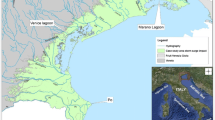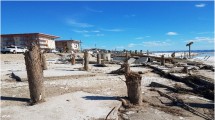Abstract
Pathways of adapting the built assets for future risk reduction are highly uncertain because of changes in socio-economic trends and climate. To provide solid foundation for better adaptation planning, this paper presents a statistical approach to investigate the future direct damage loss and the benefit of adaptation through elevating building floors of residential and commercial buildings affected by storm-tide hazard and sea-level rise in South East Queensland, Australia, particularly the implication of different extents of adaptation to policies. Because of projected socio-economic growth, it was found that, if considered separately, building stock growth causes twice as large as sea-level rise does to the potential damage loss. Adaptation by elevating new buildings alone is more cost-effective and socially acceptable than by elevating both new and old buildings. It is concluded that even with limited adaptation, immediate but less long-term net benefits could be achieved by focusing adaptation on the most vulnerable coastal housing. Somewhat pre-emptive adaptation that lifts more coastal housing in wider coastal area in the immediate term to accommodate future storm tides gives longer-term net benefits, though incurs higher adaptation costs. However, too much over-adapting may be undesirable as it incurs unreasonably high initial and on-going costs while the benefits of it could only be reaped over unrealistically long time. Geographical extent of asset adaptation should be decided in accordance with the planning time horizon to avoid either under- or over-adaptation.







Similar content being viewed by others

Explore related subjects
Discover the latest articles and news from researchers in related subjects, suggested using machine learning.References
Abbs DJ, Maheepala S, McInnes KL, Mitchell G, Shipton B, Trinidad G (2000) Climate change, urban flooding and infrastructure. Proc Hydro 2000: 3rd International Hydrology and Water Resources Symposium of the Institution of Engineers, Perth, Western Australia, pp 686–691
ABS (Australian Bureau of Statistics) (2008a) Mesh blocks digital boundaries, Australia 2006, cat. No. 1209.0.55.002, ABS, Canberra
ABS (Australian Bureau of Statistics) (2008b) Population projections, Australia, 2006 to 2101, cat. no. 3222.0, ABS, Canberra
Beckley BD, Lemoine FG, Lutchke SB, Ray RD, Zelensky NP (2007) A reassessment of global and regional mean sea level trends from TOPEX and Jason-1 altimetry based on revised reference frame and orbits. Geophys Res Lett 33, L14608
CMAR (2012) Sea level rise: Understanding the past — Improving projections for the future. http://www.cmar.csiro.au/sealevel/sl_proj_21st.html Accessed 10 Feb 2015
Delcan (2012) Cost of adaptation – sea dikes & alternative strategies. Final report, Ministry of Forests, Land and Natural Resource Operations, British Columbia, Canada
DERM (2012) Queensland coastal plan. Department of Environment and Resource Management, State of Queensland, Australia
Eastern Research Group (2013) What will adaptation cost? An economic framework for coastal community infrastructure. Final Report, National Oceanic and Atmospheric Administration (NOAA) Coastal Service Center
FEMA (2010) Home builders guide to coastal construction: technical fact sheet series. FEMA 499, Federal Emergency Management Agency, Washington
Genovese E, Przyluski V, Hallegatte S (2012) Disaster Risk Management and Territorial Governance- Lessons from Xynthia storm in France. Paper No 6048, FIG Working Week 2012, Rome, Italy
Hallegatte S (2011) Uncertainties in the cost-benefit analysis of adaptation measures, and consequences for decision making. In Climate: global change and local adaptation, I Linkov and TS Bridges (eds), NATO Science for Peace and Security Series C: Environmental Security, 169–192
Hallegatte S, Green C, Nicholls RJ, Corfee-Morlot J (2013) Future flood losses in major coastal cities. Nat Clim Chang 3:802–806
Hardy TA, Mason LB, Astorquia A (2004) Queensland climate change and community vulnerability to tropical cyclones — ocean hazards assessment — stage 3: the frequency of surge plus tide during tropical cyclones for selected open coast locations along the Queensland east coast. State of Queensland, Australia
Harper BA (1998) Storm tide threat in Queensland - History, prediction and relative risks. Conservation Technical Report No. 10, State of Queensland, Australia
Harper B, Granger K, Jones T, Stehle J, Lacey R (2000) Tropical cyclone risks. In: Granger K, Hayne M (eds) Natural hazards and the risks they pose to South-East Queensland. Australian Geological Survey Organisation, Canberra, pp 4.1–4.46
Hennessy K, Fitzharris B, Bates BC, Harvey N, Howden SM, Hughes L, Salinger J, Warrick R (2007) Australia and New Zealand. In: Parry ML, Canziani OF, Palutikof JP, van der Linden PJ, Hanson CE (eds) Climate Change 2007: Impacts, Adaptation and Vulnerability. Contribution of Working Group II to the Fourth Assessment Report of the Intergovernmental Panel on Climate Change. Cambridge University Press, Cambridge, pp 507–540
Hinkel J, Vuuren D, Nicholls RJ, Klein RJT (2013) The effects of adaptation and mitigation on coastal flood impacts during the 21st century. An application of the DIVA and IMAGE models. Clim Chang 117(4):783–794
Hirabayashi Y, Mahendran R, Kirala S, Konoshima L, Yamazaki D, Watanabe S, Kim H, Kanae S (2013) Global flood risk under climate change. Nat Clim Chang 3(9):816–821
Hurricane Sandy Rebuilding Task Force (2013) Hurricane Sandy rebuilding strategy — Stronger communities, a resilient region. Presented to the President of the United States, August 2013
ICSM (2012) Geocentric datum of Australia Technical Manual. Version 2.3(1). Available at http://www.icsm.gov.au/icsm/gda/gdatm/gdav2.3.pdf Accessed 5 Mar 2012
Kennedy A, Robertson E (2003) 2001 Census: housing (Census paper No. 03/02). Australian Bureau of Statistics, Canberra
Knabb RD, Rhome JR, Brown DP (2005) Tropical cyclone report Hurricane Katrina 23-30 August 2005. Updated 14 September 2011, National Hurricane Center
Lin B, Khoo Y, Inman M, Wang C-H, Tapsuwan S, Wang X (2014) Assessing inundation damage and timing of adaptation: sea level rise and the complexities if land use in coastal communities. Mitig Adapt Strat Glob Chang 19:551–568
Macintosh A (2013) Coastal climate hazards and urban planning: how planning responses can lead to maladaptation. Mitig Adapt Strat Glob Chang 18(7):1035–1055
McBride JL (2010) Climate change impacts on tropical cyclones: the current state of knowledge. 14th Australas Wind Eng Soc Workshop, Canberra 87–90
McMonagle CJ (1979) Storm surge and tide investigation for new Brisbane airport. Blain Bremner and Williams
Meehl GA, Stocker TF, Collins WD, Friedlingstein P, Gaye AT, Gregory JM, Kitho A, Knutti R, Murphy JM, Noda A, Raper SCB, Watterson IG, Weaver AJ, Zhao Z-C (2007) Global climate projection. In: Solomon S, Qin D, Manning M, Chen Z, Marquis M, Averyt KB, Tignor M, Miller HL (eds) The physical science basis. Contribution of Working Group I to the Fourth Assessment Report of the Intergovernmental Panel on Climate Change. Cambridge University Press, Cambridge
Michael JA (2007) Episodic flooding and the cost of sea-level rise. Ecol Econ 63(1):149–159
Morgan MG, Kandlikar M, Risbey J, Dowlatabadi H (1999) Why conventional tools for policy analysis are often inadequate for problems of global change. Clim Chang 41(3–4):271–281
PSMA (2010) Cadastre theme for the CadLite dataset
QNRM (2002) Guidance on the assessment of tangible flood damages. Department of Natural Resources and Mines, State of Queensland, Australia
QNRM (2004) Queensland climate change and community vulnerability to tropical cyclones — ocean hazards assessment — synthesis report: an overview and discussion of results from project stages 2, 3 and 4. State of Queensland, Australia
QOCC (2010) Climate change in Queensland: what the science is telling us. Office of Climate Change, State of Queensland, Australia
Rahmstorf S, Cazenave A, Church JA, Hansen JE, Keeling R, Parker DE, Somerville RCJ (2007) Recent climate observations compared to projections. Science 316:709
Rambaldi AN, Fletcher CS, Collins K, McAllister RRJ (2013) Housing shadow prices in an inundation prone suburb. Urban Studies 50(9) DOI: 10.1177/0042098012465904
Rao AD, Murty PLN, Jain I, Kankara RS, Dube SK, Murty TS (2013) Simulation of water levels and extent of coastal inundation due to a cyclonic storm along the east coast of India. Nat Haz 66(3):1431–1441
Rawlinsons Group (2013) Rawlinson’s Australian construction handbook 2013, 31st edn. Rawlhouse Publishing, Sydney
Reisinger A, Kitching RL, Chiew F, Hughes L, Newton PCD, Schuster SS, Tait A, Whetton P et al (2014) Australasia. In: Barros VR, Field CB, Dokken DJ, Mach KJ, Bilir TE, Chatterjee M, Ebi KL, Estrada YO, Genova RC, Girma B, Kissel ES, Levy AN, MacCracken S, Mastrandrea PR, White LL (eds) Climate Change 2014: impacts, adaptation, and vulnerability. Part B: regional aspects. Contribution of Working Group II to the Fifth Assessment Report of the Intergovernmental Panel on Climate Change. Cambridge University Press, Cambridge
Rhodes J (2010) Managing the parameters of Visibility: the revelations of Katrina. Urban Stud 47:2051–2068
Rogelj J, Meinshausen M, Knutti R (2012) Global warming under old and new scenarios using IPCC climate sensitivity range estimates. Nat Clim Chang 2:248–253
Rosenzweig C, Solecki W (2014) Hurricane Sandy and adaptation pathways in New York: lessons from a first-responder city. Glob Environ Chang 28:395–408
Rosenzweig C, Solecki W, Blake R, Bowman M, Faris C, Cornitz V, Horton R et al. (2011) Developing coastal adaptation to climate change in the New York City infrastructure-shed: process, approach, tools, and strategies. 106(1):93–127
Smith DI, Greenaway MA (1994) Tropical storm surge, damage assessment and emergency planning: a pilot study for Mackay, Queensland. Resource and Environmental Studies 8, Australian National University, Canberra
Trowbridge J, Minto J, Berrill J (2011) Natural disaster insurance review — Inquiry into flood insurance and related matters. The Australian Government the Treasury, Canberra
Wang C-H, Wang X, Khoo YB (2013) Extreme wind gust hazard in Australia and its sensitivity to climate change. Nat Hazards 67:549–567
Wang X, Khoo YB, Wang C-H (2014) Risk assessment and decision-making for residential housing adapting to increasing storm-tide inundation due to sea-level rise in South East Queensland, Australia. Civ Eng Environ Syst 31(2):125–139
Wang C-H, Baynes T, McFallan S et al (2015) Rising tides — adaptation policy alternatives for coastal residential buildings in Australia. Struct Infrastruct Eng. doi:10.1080/15732479.2015.1020500
Yohe GW (2003) More trouble for cost-benefit analysis. Clim Chang 56(3):235–244
Acknowledgments
This study is part of the South East Queensland Climate Adaptation Research Initiative (SEQCARI). This paper has been improved by the constructive comments of the anonymous reviewers.
Author information
Authors and Affiliations
Corresponding author
Electronic supplementary material
Below is the link to the electronic supplementary material.
ESM 1
(DOCX 55 kb)
Rights and permissions
About this article
Cite this article
Wang, CH., Khoo, Y.B. & Wang, X. Adaptation benefits and costs of raising coastal buildings under storm-tide inundation in South East Queensland, Australia. Climatic Change 132, 545–558 (2015). https://doi.org/10.1007/s10584-015-1454-7
Received:
Accepted:
Published:
Issue Date:
DOI: https://doi.org/10.1007/s10584-015-1454-7



